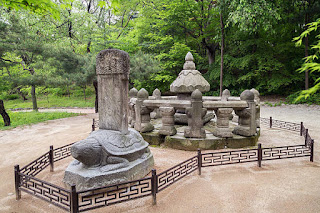Changgyeonggung Palace is one of the five grand palaces built in joseon dynasty period. This palace was built by king Sejong in the mid of 15th century for his father (Taejong). It was originally named as 'Suganggung Palace'.
 |
| Changgyeonggung Palace |
In 1480's, when king Seongjong ascended the throne he renovated and extended this palace and renamed it as 'Changgyeonggung'.
This palace was destroyed by fire in 1592 during the Imjin war. However, it was partially rebuilt by latter joseon kings. But during japanese colonial period (1910-1945) this palace was again destroyed but this time the japanese built a botanical garden, a zoo and a museum on that location. During that time the Changgyeonggung Palace was known as 'Changgeongwon' (Changgeon Garden).
These changes on the palace ground remained the same until 1983.
After the Independence (1945) and Korean war (1950-53) the zoo was refilled with animals with the help of wealthy koreans and with those animals that were gifted from thee foreign zoos.
In 1983, under the initiative taken by Korean government to rebuilt all five grand palaces that were destroyed during japanese invasion, the Korean government moved the zoo to present day Seoul Grand Park.
Different Structures at Changgyeonggung Palace....
- Myeongjeongjeon ( Throne Hall)
This is the main gate of palace. It was originally built in 1484 by king Seongjong. The gate was destroyed in 1592 during Imjin war and rebuilt in 17th century. This is a wooden gate. There are two bell pavilions (Sipjagak) on each side of the gate.
- Okcheongjo Bridge
- Angbuilgu sundial
- Daeonsil (Green House)
- Gyeongchunjeong Hall
This hall was destroyed two times by the japanese first in 1592 during Imjin war ( rebuilt - 1616) and second time in 1830 and was rebuilt in 1834.
Gyeongchunjeong Hall was also used as the birth place - King Jeongjo 9 22nd King of joseon dynasty) was born ere in 1752 and King Heonjong (24th King) was also born here in 1827.
King Jeongjo named this hall as 'Birth Hall'. His mother Lady Hyegyeong breathed her last in this hall.
- Hwangyeongjeon Hall
This hall was destroyed in 1592 during Imjin war and rebuilt in 1616 but again in1830, this hall was destroyed by fire but again rebuilt in 1834.
In 1544, King Jungjong breathed his last in this hall and in 1645 crown prince Sohyeon also died in this hall.
- Sungmundang Hall
It was destroyed in 1830. However, again rebuilt the same year.
- Tongmyeongjeon Hall
Near the hall there is an elevated stone terrace.
- Tonghwadang Hall
It was built in 1484 by king Seonjong.
- Munjeongjeon Hall
- Gwandeokjeong Pavilion
- Haminjeong Pavilion
this pavilion was used for royal feasts and ceremonies. The King used to meet the military officials here. It was built in 1633, destroyed in 1830 and and rebuilt in 1833.
- Jagyeongjeon Site
Duerng the japanese invasion this building was destroyed and a royal library was built on this location. The library was removed by this Korean government in 1992.
- Chunganji Pond
These are two ponds located near the green house. 'Daechundangi' and 'Sochundangi' (Smaller). The surrounding area of the pond was used for farming.
- Taesil Shrine
Taesil Shrines were used to store placenta of the children of the royal family. King Seongjong's placenta is stored here and there is also a stone tablet with the information about his placenta.
- Punggidae
This innovative device was constructed in 18th century. It was used to measure the speed and direction of the wind.
안녕하세요 여러분! Hello!
How did you like this article?
Please leave your thoughts in comment section...
and stay connected for something new.
Until then Follow Your Dreams.....
안녕!








Comments
Post a Comment